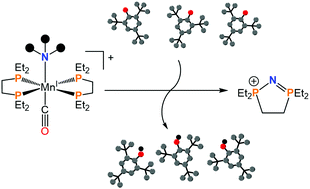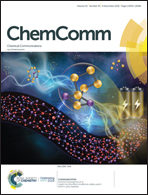Triple hydrogen atom abstraction from Mn–NH3 complexes results in cyclophosphazenium cations†
Abstract
All hydrogen atoms of the NH3 in [Mn(depe)2(CO)(NH3)]+ are abstracted by 2,4,6-tri-tert-butylphenoxyl radical, resulting in the isolation of a rare cyclophosphazenium cation, [(Et2P(CH2)2PEt2)N]+, in 76% yield. An analogous reaction is observed for [Mn(dppe)2(CO)(NH3)]+. Computations suggest insertion of NHx into a Mn–P bond provides the thermodynamic driving force. Contextualization of this reaction provides insights on catalyst design and breaking strong N–H bonds.



 Please wait while we load your content...
Please wait while we load your content...
